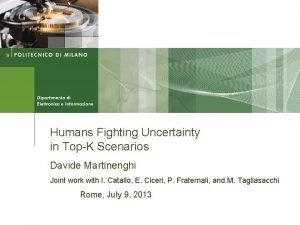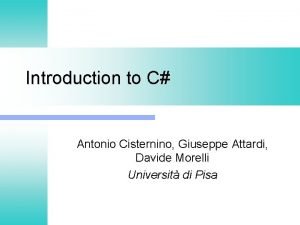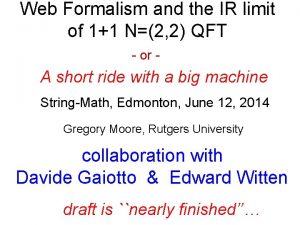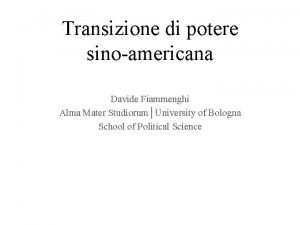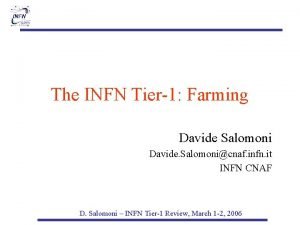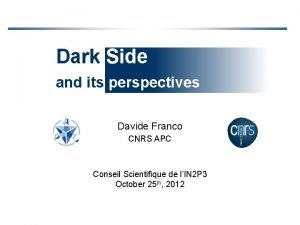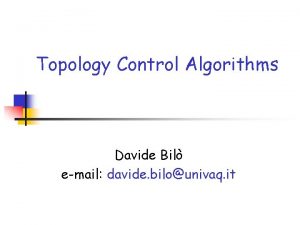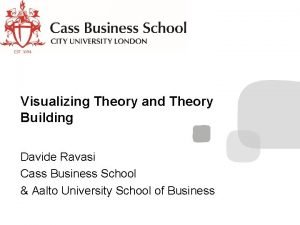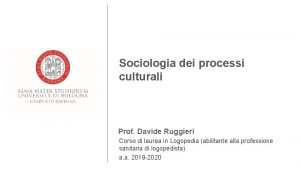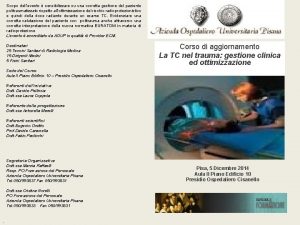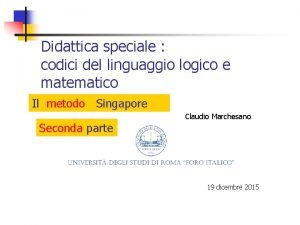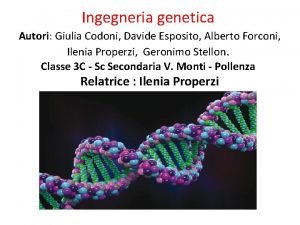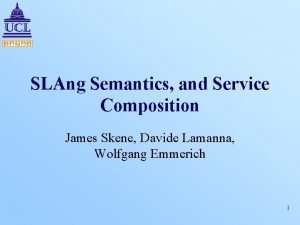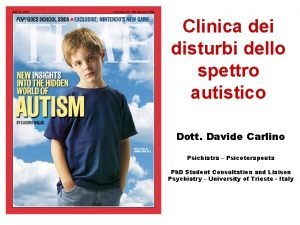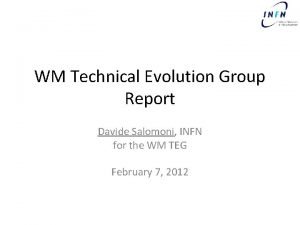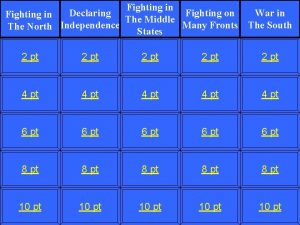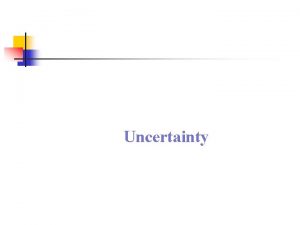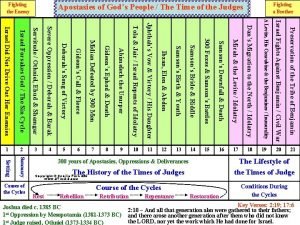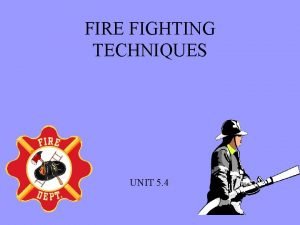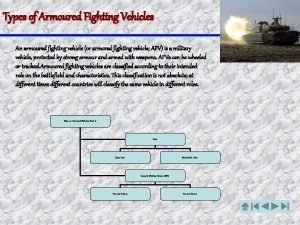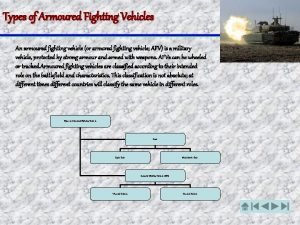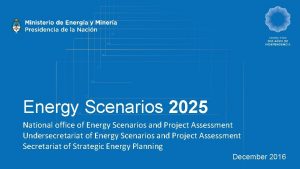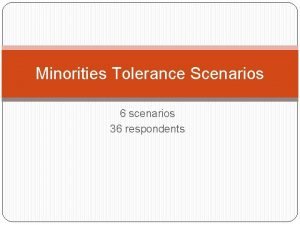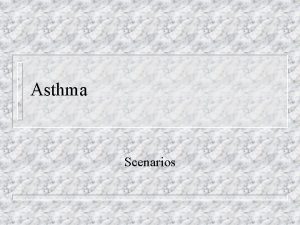Humans Fighting Uncertainty in TopK Scenarios Davide Martinenghi




![Rank aggregation 5 [Fagin, PODS 1996] § Rank aggregation is the problem of combining Rank aggregation 5 [Fagin, PODS 1996] § Rank aggregation is the problem of combining](https://slidetodoc.com/presentation_image/07bac9ecacf9e76c7922438aedb7e338/image-5.jpg)


![Reverse top-k queries 8 [Vlachou et al. , ICDE 2010] § Aggregation function: Score(cand) Reverse top-k queries 8 [Vlachou et al. , ICDE 2010] § Aggregation function: Score(cand)](https://slidetodoc.com/presentation_image/07bac9ecacf9e76c7922438aedb7e338/image-8.jpg)

![Ranking in the real world 10 [Calì & Martinenghi, ICDE 2008] [Martinenghi & Tagliasacchi, Ranking in the real world 10 [Calì & Martinenghi, ICDE 2008] [Martinenghi & Tagliasacchi,](https://slidetodoc.com/presentation_image/07bac9ecacf9e76c7922438aedb7e338/image-10.jpg)
![Uncertain scoring 11 [Soliman & Ilyas, ICDE 2009], [Soliman et al. , SIGMOD 2011] Uncertain scoring 11 [Soliman & Ilyas, ICDE 2009], [Soliman et al. , SIGMOD 2011]](https://slidetodoc.com/presentation_image/07bac9ecacf9e76c7922438aedb7e338/image-11.jpg)








![Uncertainty reduction via question answering [Li & Deshpande, VLDB 2010] § When several orderings Uncertainty reduction via question answering [Li & Deshpande, VLDB 2010] § When several orderings](https://slidetodoc.com/presentation_image/07bac9ecacf9e76c7922438aedb7e338/image-20.jpg)









![Task assignment: Motivations 30 [Raykar et al. , J. of Machine Learning Research 2010] Task assignment: Motivations 30 [Raykar et al. , J. of Machine Learning Research 2010]](https://slidetodoc.com/presentation_image/07bac9ecacf9e76c7922438aedb7e338/image-30.jpg)





- Slides: 35

Humans Fighting Uncertainty in Top-K Scenarios Davide Martinenghi Joint work with I. Catallo, E. Ciceri, P. Fraternali, and M. Tagliasacchi Rome, July 9, 2013

Summary 2 § Rank aggregation and rank join § Uncertain scoring § Representative orderings § Reducing uncertainty through human workers Search Computing

Ranking queries 3 § Main idea: focus on the best query answers according to some criterion, without computing the full result • A. k. a. “top-k” queries § Main applications: • • Combination of user preferences expressed according to various criteria – Example: ranking restaurants by combining criteria about culinary preference, driving distance, stars, … Nearest neighbor problem (e. g. , similarity search) – Given a database D of n points in some metric space, and a query q in the same space, find the point (or the k points) in D closest to q Search computing – “Where can I attend an interesting conference in my field close to a sunny beach? ” … Search Computing

Ranking queries: example 4 SELECT h. neighborhood, h. hid, r. rid FROM Hotels. NY h, Restaurants. NY r WHERE h. neighborhood = r. neighborhood RANK BY 0. 4/h. price + 0. 4*r. rating + 0. 2*r. has. Music LIMIT 5 Full Join Results Rank Join Results Neighborhood Hid Rid West Village Midtown East Chelsea Midtown East Hell’s Kitchen Midtown West Upper East Side Harlem Tribeca H 89 H 248 H 427 H 248 H 597 H 662 H 141 H 978 H 355 H 381 R 585 R 197 R 572 R 346 R 197 R 223 R 276 R 137 R 49 R 938 East Village Gramercy Midtown West Hell’s Kitchen Upper West Side H 346 H 872 H 141 H 662 H 51 R 738 R 822 R 276 R 498 R 394 • • • Search Computing
![Rank aggregation 5 Fagin PODS 1996 Rank aggregation is the problem of combining Rank aggregation 5 [Fagin, PODS 1996] § Rank aggregation is the problem of combining](https://slidetodoc.com/presentation_image/07bac9ecacf9e76c7922438aedb7e338/image-5.jpg)
Rank aggregation 5 [Fagin, PODS 1996] § Rank aggregation is the problem of combining several ranked lists of objects in a robust way to produce a single consensus ranking of the objects Candidate Candidate 1 2 4 5 3 2 4 2 1 5 3 5 5 3 1 4 1 3 4 2 5 3 1 2 4 Judge 1 Judge 2 Judge 3 § What is the overall ranking? § Who is the best candidate? Search Computing Judge 4 Judge 5

Rank aggregation and scores 6 § Metric approaches are preferred over axiomatic approaches (Arrow’s impossibility theorem) § When scores are opaque, the goal is to find a new ranking R whose total distance to the initial rankings R 1, …, Rn is minimized • • For several metrics, NP-hard to solve exactly – E. g. , the Kendall tau distance K(R 1, R 2), defined as the number of exchanges in a bubble sort to convert R 1 to Rn May admit efficient approximations (e. g. , median ranking) § When scores are visible, the consensus ranking is determined by means of an aggregation function Search Computing

Rank aggregation – example with scores 7 § Aggregation function: Score(cand) = 0. 30 s 1 + 0. 25 s 2 + 0. 20 s 3 + 0. 15 s 4 + 0. 10 s 5 Cand s 1 Cand s 2 Cand s 3 Cand s 4 Cand s 5 1 . 9 2 . 65 4 . 99 5 . 6 3 . 8 2 . 7 1 . 6 2 . 97 1 . 5 1 . 7 3 . 5 5 . 55 5 . 95 3 . 4 5 . 65 4 . 3 4 . 5 3 . 93 4 . 3 2 . 63 5 . 1 3 . 45 1 . 91 2 . 2 4 . 62 Judge 1 Judge 2 Judge 3 § What is the overall ranking? § Who is the best candidate? Search Computing Judge 4 Judge 5
![Reverse topk queries 8 Vlachou et al ICDE 2010 Aggregation function Scorecand Reverse top-k queries 8 [Vlachou et al. , ICDE 2010] § Aggregation function: Score(cand)](https://slidetodoc.com/presentation_image/07bac9ecacf9e76c7922438aedb7e338/image-8.jpg)
Reverse top-k queries 8 [Vlachou et al. , ICDE 2010] § Aggregation function: Score(cand) = w 1 s 1 + w 2 s 2 + w 3 s 3 + w 4 s 4 + w 5 s 5 Cand s 1 Cand s 2 Cand s 3 Cand s 4 Cand s 5 1 . 9 2 . 65 4 . 99 5 . 6 3 . 8 2 . 7 1 . 6 2 . 97 1 . 5 1 . 7 3 . 5 5 . 55 5 . 95 3 . 4 5 . 65 4 . 3 4 . 5 3 . 93 4 . 3 2 . 63 5 . 1 3 . 45 1 . 91 2 . 2 4 . 62 Judge 1 Judge 2 Judge 3 Judge 4 Judge 5 § What weights should I convince you to use so that my preferred candidate becomes the best? • (point of view of the seller/product manufacturer) Search Computing

Rank aggregation in data-centric contexts 9 § Traditionally, two ways of accessing data: • • Sorted access: access, one by one, the next element (together with its score) in a ranked list, starting from top Random access: given an element (id), retrieve its score (position in the ranked list or other associated value) § Minimizing the accesses when determining the top k items • • • A cost is incurred for each item read from a ranking Can I improve on the current best aggregate score if I read more items? Thresholds are used to ensure that no further item needs to be read Search Computing
![Ranking in the real world 10 Calì Martinenghi ICDE 2008 Martinenghi Tagliasacchi Ranking in the real world 10 [Calì & Martinenghi, ICDE 2008] [Martinenghi & Tagliasacchi,](https://slidetodoc.com/presentation_image/07bac9ecacf9e76c7922438aedb7e338/image-10.jpg)
Ranking in the real world 10 [Calì & Martinenghi, ICDE 2008] [Martinenghi & Tagliasacchi, TKDE 2012] § Almost relational model, with a lot of “quirks” • • Web interfaces with input and output fields (access patterns) Results are typically ranked trip. Advisor(Cityi, In. Datei, Out. Datei, Personsi, Nameo, Popularityo, ranked) • Many other needs: joins, dirty data, deduplication, diversification, uncertainty, incompleteness, recency, paging, access costs… Search Computing
![Uncertain scoring 11 Soliman Ilyas ICDE 2009 Soliman et al SIGMOD 2011 Uncertain scoring 11 [Soliman & Ilyas, ICDE 2009], [Soliman et al. , SIGMOD 2011]](https://slidetodoc.com/presentation_image/07bac9ecacf9e76c7922438aedb7e338/image-11.jpg)
Uncertain scoring 11 [Soliman & Ilyas, ICDE 2009], [Soliman et al. , SIGMOD 2011] § Users are often unable to precisely specify the scoring function § Objects may have imprecise scores, e. g. , defined over intervals – E. g. , apartment rent [$200 -$250] § Using trial-and-error or machine learning may be tedious and time consuming § Even when the function is known, it is crucial to analyze the sensitivity of the computed ordering wrt. changes in the function Search Computing

Uncertain scoring 12 § Assumptions: • Linear scoring function: S = w 1 s 1 + … + wnsn • User-defined weights w 1, …, wn are uncertain, and, w. l. o. g. , normalized to sum up to 1 § Each point on the simplex represents a possible scoring function Search Computing

Example § Top-k query: • Results and possible orderings: Search Computing 13

Representative ordering 14 § Both value uncertainty and weight uncertainty determine score uncertainty • This induces a partial order over objects • we have a space of possible orderings § We focus on a representative of the space § An example is the Most Probable Ordering § Other definitions of representative ordering exist, e. g. , the Optimal Rank Aggregation Search Computing

Example of MPO § For K=2, the MPO is <τ2, τ3> • under the assumption of uniform probability distribution Search Computing 15

Shortcomings of representative orderings 16 § Complex to compute: • exponential in the number of dimensions (weights) • in some cases, NP-hard already in 3 D § MPOs may fail to be truly representative: • often, only slightly better than the second most probable ordering • how stable is the ordering? would it remain the same after a slight perturbation of the weights? Search Computing

Points corresponding to join results for d=2 Search Computing 17

Construction of tree of possible orderings Search Computing 18

Asking humans 19 § Question answering: • How to use human workers to reduce the amount of uncertainty? • Which questions to pose? § Task assignment: • Once the tasks are defined, which humans to ask? Search Computing
![Uncertainty reduction via question answering Li Deshpande VLDB 2010 When several orderings Uncertainty reduction via question answering [Li & Deshpande, VLDB 2010] § When several orderings](https://slidetodoc.com/presentation_image/07bac9ecacf9e76c7922438aedb7e338/image-20.jpg)
Uncertainty reduction via question answering [Li & Deshpande, VLDB 2010] § When several orderings are possible, the space of possible orderings compatible with the score values can be determined and represented as a tree § Each node is associated with a probability Uncertain attribute value: multiple values are possible t 1 t 2 t 3 Search Computing Several orderings are possible score Each path in the tree represents a possible ordering

Uncertainty reduction via question answering Determining the best ordering REQUIRES TO Reduce uncertainty in the space of possible orderings Prune paths Search Computing

Solution: crowdsourcing Crowd Questions User knowledge 1) Resolve conflicts (i. e. , ambiguities on the ordering of two or more objects) 2) Refine score intervals Reduce uncertainty in the space of possible orderings Search Computing Prune paths

Showcase: tree construction Search Computing

Showcase: question answering s” e “Y “N Search Computing o”

Open issue: question types § Questions • Define the types of possible questions • Define how to measure uncertainty in the space of possible orderings, so as to check its reduction as questions are answered § Measuring uncertainty • Shannon’s entropy (or some discounted version thereof) • Distance from a representative ordering • … § Uncertainty reduction • Devise the optimal set/sequence of Q questions that can be posed to users Search Computing

First solution: Online approach 1 Select the most promising question q 1 As kq 1 2 Modify tree Select the most 3 promising question q 2 (taking into account previous tree updates) … Search Computing Answer As k q 2

Second solution: Offline approach 1 Select the Q most promising questions <q 1…q. Q> For each selected qi Ask qi 2 Search Computing Modify tree Answer

Comparison Online Approach PROS Optimized with respect to the actual system state Offline approach Fast user interaction (questions are chosen before interacting with the user) CONS Slow user interaction Questions are chosen (questions are evaluated according to the initial at each step) system state (+some clues about the future gains), not according to the system state at each step Search Computing

Crowdsourcing marketplaces § Crowdsourcing marketplaces: Internet marketplaces that enable requesters to hire crowd workers to perform tasks Search Computing
![Task assignment Motivations 30 Raykar et al J of Machine Learning Research 2010 Task assignment: Motivations 30 [Raykar et al. , J. of Machine Learning Research 2010]](https://slidetodoc.com/presentation_image/07bac9ecacf9e76c7922438aedb7e338/image-30.jpg)
Task assignment: Motivations 30 [Raykar et al. , J. of Machine Learning Research 2010] § It is often the case that a worker does not have the appropriate knowledge for annotating all the data, even for a particular domain § Each worker is characterized by different parameters we should take into consideration § Examples: • Expertise • Geocultural information • Past work history § Problem: How to associate the most suitable task with the most appropriate worker(s)? Search Computing

Task assignment: Definition § Task assignment: identify the best assignment configuration between workers and tasks, given an upper bound on the number of assignments or a delay constraint (i. e. , who should work on what? ) § Expressed by means of a bipartite assignment graph § Constrained maximization problem (maximize assignment quality over all feasible task-annotator assignments) Search Computing 31

Objectives and parameters 32 § Parameters of interest: • Worker model: accuracy (probability of correctly solving the task), fatigue decay, cost, correlation • Task model: uncertainty § Optimal allocation • Possible objectives: – Achieving maximum quality given a target budget – Ensuring that tasks finish before a target deadline Search Computing

Execution pipeline of a task assignment policy Search Computing 33

Experimental assessment 34 § Parameters of interest: • Tasks’ quality and completion rate w. r. t. to workers’ accuracy distributions • Optimal budget B* w. r. t. expected number of workers § Experimental assessment: • On publicly available data sets (e. g. , UCI repository) • On real crowds (e. g. , Micro. Task) Search Computing

Acknowledgments: CUb. RIK Project § CUb. RIK is a research project financed by the European Union § Goals: • Advance the architecture of multimedia search • Exploit the human contribution in multimedia search • Use open-source components provided by the community • Start up a search business ecosystem § http: //www. cubrikproject. eu/ Search Computing 35
 Davide damosso
Davide damosso Davide martinenghi
Davide martinenghi Osanna osanna al figlio di davide
Osanna osanna al figlio di davide Davide galliani
Davide galliani Davide chiarini
Davide chiarini Salvatore davide porzio
Salvatore davide porzio Polisportiva san donato
Polisportiva san donato Davide cisternino
Davide cisternino Davide gaiotto
Davide gaiotto Davide fiammenghi
Davide fiammenghi Davide salomoni
Davide salomoni Emilio promette al figlio davide
Emilio promette al figlio davide Davide morotti
Davide morotti Davide pilotto
Davide pilotto Arcella classification
Arcella classification Davide bilo
Davide bilo Davide ravasi
Davide ravasi Sultex textile
Sultex textile Davide martins
Davide martins Davide ruggieri
Davide ruggieri Davide ruggieri unibo
Davide ruggieri unibo Davide mongelli
Davide mongelli Davide soloperto
Davide soloperto Davide albano
Davide albano Davide caramella
Davide caramella Andrea beatrice chiara davide
Andrea beatrice chiara davide Davide baroni
Davide baroni Davide piva
Davide piva Venzano davide oculista genova
Venzano davide oculista genova Davide codoni
Davide codoni Davide sla
Davide sla Davide mazza polimi
Davide mazza polimi Davide lauro tor vergata
Davide lauro tor vergata Davide carlino psichiatra
Davide carlino psichiatra Davide manstretta
Davide manstretta Alessandra salomoni
Alessandra salomoni

